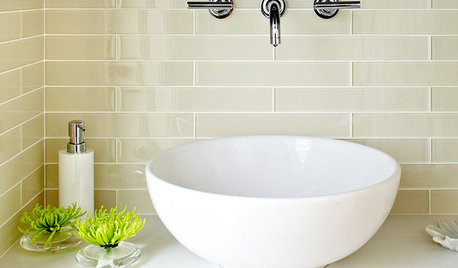Drill bit questions
jally
12 years ago
Related Stories

DOORS5 Questions to Ask Before Installing a Barn Door
Find out whether that barn door you love is the right solution for your space
Full Story
REMODELING GUIDESSurvive Your Home Remodel: 11 Must-Ask Questions
Plan ahead to keep minor hassles from turning into major headaches during an extensive renovation
Full Story
SELLING YOUR HOUSE15 Questions to Ask When Interviewing a Real Estate Agent
Here’s what you should find out before selecting an agent to sell your home
Full Story
REMODELING GUIDESFinishing Touches: Pro Tricks for Installing Fixtures in Your Tile
Cracked tile, broken drill bits and sloppy-looking fixture installations? Not when you follow these pro tips
Full Story
KITCHEN DESIGN9 Questions to Ask When Planning a Kitchen Pantry
Avoid blunders and get the storage space and layout you need by asking these questions before you begin
Full Story

REMODELING GUIDES13 Essential Questions to Ask Yourself Before Tackling a Renovation
No one knows you better than yourself, so to get the remodel you truly want, consider these questions first
Full Story
Easy Green: 6 Must-Answer Questions Before You Buy
Thinking about buying ecofriendly furniture? For a truly environmentally conscious home, ask yourself these questions first
Full Story
FEEL-GOOD HOMEThe Question That Can Make You Love Your Home More
Change your relationship with your house for the better by focusing on the answer to something designers often ask
Full Story
WORKING WITH PROS12 Questions Your Interior Designer Should Ask You
The best decorators aren’t dictators — and they’re not mind readers either. To understand your tastes, they need this essential info
Full StoryMore Discussions






mike_kaiser_gw
jallyOriginal Author
Related Professionals
University City Kitchen & Bathroom Remodelers · Fort Washington Kitchen & Bathroom Remodelers · Port Arthur Kitchen & Bathroom Remodelers · Superior Kitchen & Bathroom Remodelers · Abington General Contractors · Artesia General Contractors · Enumclaw General Contractors · Great Falls General Contractors · Jacinto City General Contractors · Brooklyn Park Painters · Camden Painters · Denver Painters · Lynnwood Painters · Moss Point Painters · San Diego Paintersbrickeyee
jallyOriginal Author
jallyOriginal Author
sierraeast
User
brickeyee
mike_kaiser_gw
lazypup
brickeyee
graywings123
millworkman
lazypup
sombreuil_mongrel
jallyOriginal Author
mike_kaiser_gw
brickeyee
sierraeast
jallyOriginal Author
mike_kaiser_gw
jallyOriginal Author
jallyOriginal Author